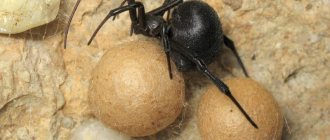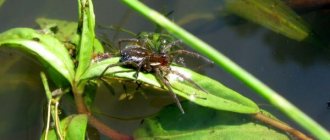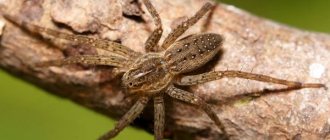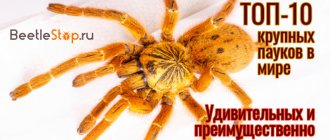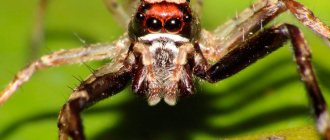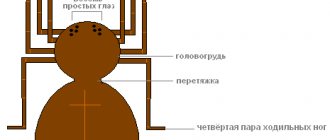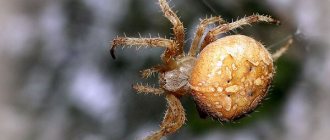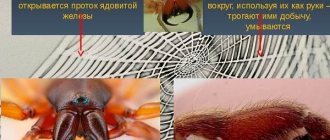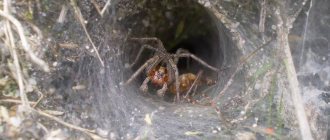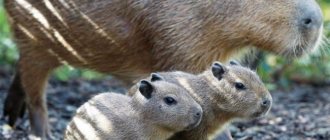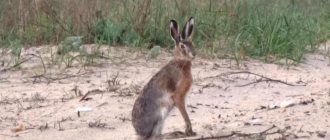There are several names for this most poisonous karakurt spider that lives on our Planet. This spider is called a “black worm”, and translated from Kalmyk spider it is called a “black widow”. The last name is the most suitable for this type of spider, since females after mating can easily eat their sexual partners. The Black Widow is no less dangerous to humans. Naturally, this applies more to sexually mature females. These spiders move relatively quickly.
Experts have proven that karakurt venom is one and a half to two dozen times more toxic than the toxicity of the venom of the most poisonous snake living in the wild. Males are not capable of causing harm to humans, since they are characterized by significantly smaller sizes, and they are not able to bite through human skin. For humans, a “black widow” is also a mystical living creature due to the fact that there are 13 red spots on the spider’s body.
Why is the karakurt spider called the “black widow”?
This name is given not only to female spiders, but to the entire species as a whole. The reasons that they received this name are two facts:
- spiders are black with red spots on the abdomen. By the way, adult females may lack spots, which is why they become pure black, making them even more similar to a black widow;
- immediately after mating, the female eats her male (in the vast majority of cases).
Characteristics of the karakurt spider
Karakurt spider, appearance
Spiders of this species have a ball-shaped abdomen and a cephalothorax. They are connected to each other by the seventh segment of the cephalothorax. From the abdomen come two pairs of jaws and four pairs of legs. The female has two upper jaws (chelicerae), at the ends of which there are hooks. On the other side of the jaws are poisonous glands.
As already mentioned, they are black in color and most often have red spots on the abdomen. Over time, females may lose their red spots, and yellow stripes may also appear. It depends on their habitat. Eurasian female karakurts are solid black, while American and Australian ones always have spots.
A distinctive feature of this species is pronounced sexual dimorphism: the female is 3-4 times larger than the male. On average, the size of males is only 5-7 mm, and females are up to 20 mm.
It is also interesting that the karakurt spider has blue blood, not red, since blue (copper) hemocyanin is responsible for its formation.
Habitat of the karakurt spider
Since the bite of this type of spider is incredibly dangerous, it is of course important to know where they live in order to protect yourself.
Spiders prefer to be in forest-steppe, steppe and semi-desert zones, where there is a warm climate. They can be encountered in southern Europe, Central Asia and North Africa.
If we talk about countries near Russia, then karakurt spiders live in Azerbaijan, Kazakhstan, and not so long ago they were found in the Donetsk region.
Unfortunately, in Russia itself, spiders are quite widespread. They can be found mainly in the southern regions, located in the steppe zones, namely: In the Rostov, Astrakhan and Novosibirsk regions, Altai Territory and Crimea.
There were isolated cases when these dangerous spiders were encountered in the Moscow region. Due to the extreme heat, spiders migrated to these areas. But they do not stay there, because harsh winters are destructive for karakurt spiders.
Karakurts hide in the steppes, arable lands, wastelands, salt marshes and near ravines. They settle in crevices, burrows, depressions in the ground and walls of adobe houses. Sometimes they can be found in abandoned buildings.
Karakurt, front view
Karakurt spider from the black widow family
Karakurt, black color
Reproduction of karakurt spiders
The mating season of spiders occurs in the summer. Having found a secluded place, the spider makes a web, filling it with the scent of its pheromones, which attract the female.
After mating, the female eats the male. Then she looks for a place where she can lay eggs, for example, in rodent burrows or other secluded places.
On average, a clutch contains up to 130 eggs. But sometimes, about once every 10-15 years, there are bursts of reproduction of these dangerous spiders, when the female is able to lay up to 1300 eggs in one season.
The female makes 2-4 cocoons and places eggs in them. She weaves a web and attaches cocoons to it. When the autumn cold sets in, the female dies.
The cocoons reliably protect the eggs from the cold, thanks to which the future offspring of the karakurt survive the winter, and in the spring they get out of it and begin to independently fight for survival.
A strong wind can tear off cocoons, which begin to move under its force, thereby increasing the habitat of this type of spider.
Spiders hatch from eggs 10-15 days after laying, depending on the weather, but remain in the cocoon until spring. First, they feed on the food reserves stored in their bodies, and then they begin to eat each other.
They grow into adults during the spring and summer. In the process of growing up, male spiders go through seven molts, and females go through nine.
Karakurt in the web, photo
Karakurt spider, reproduction
Female karakurt with cubs
Caring for offspring
Nest of karakurt
Caring for the offspring of karakurt females is clearly expressed during the incubation period. First of all, they look for a place for future laying, digging a nest in the ground, or adapting abandoned rodent burrows for this purpose. Before entering the nest, she pulls the trapping nets. And only then do they lay cocoons with eggs. Females remain in the nest throughout the incubation period. Juveniles usually appear in April.
With the appearance of the offspring, the maternal functions of the female are completed and the young, attached to the webs, are carried away by the wind. By the beginning of summer, young karakurt animals reach maturity and are capable of mating.
Interesting: Interesting features of the structure and nutrition of animals - photos and videos
Who is dangerous for karakurt?
Despite the fact that this type of spider is considered the most dangerous in the world, and its bite can kill, karakurts have their own enemies who can destroy them.
The natural enemies of karakurts are herd animals. Sheep, cows and horses can trample hectares of steppe and destroy all the spiders living there.
Spiders are the diet of some animals and insects. For example, hedgehogs are not at all afraid of karakurts, because armor made of needles reliably protects them, so they can eat a spider of this species.
The spider nymphs lay their eggs directly into cocoons made by the female black widow, and their larvae eat the spider nymphs.
Sphex wasps attack spiders, inject them with paralyzing poison, and then kill them.
Precautionary measures
Karakurt spider.
The web and the spider itself are on the ground, and in the areas where it lives, it is important to use reliable closed shoes. The spider also weaves its webs in the grass; before starting work in the garden, you need to carefully scan the area for the presence of cobwebs. There have been cases when a spider took up residence in shoes left on the site.
Karakurt often makes its web in the hoof marks of domestic animals in pastures. Livestock often suffer from its bites. The karakurt poison is especially dangerous for horses and camels, and usually these animals die after being bitten.
Interestingly, sheep and goats are immune to spider bites.
How dangerous is a karakurt bite for humans? What to do in this case?
The spider does not purposefully attack a person, but if it feels threatened, for example, someone has touched its web, it will bite. Its bite can be fatal. It is 15 times more dangerous than a rattlesnake bite!
Karakurt males cannot bite through the skin of humans and many species of animals, in addition, they do not have glands with poison, so males are not dangerous, unlike females.
Symptoms of a karakurt bite
They appear quickly, the first signs can be seen after 10-15 minutes.
First, all the muscles in the body begin to ache; it feels like a cold. All the muscles of the chest, abs and lower back hurt.
The heart rate increases, shortness of breath, dizziness, tremors of the limbs and priapism appear in men.
Afterwards, vomiting begins, the body becomes weakened, and the person has poor control of the limbs.
Then nervous exhaustion of the body sets in, and depression may appear. Consciousness becomes cloudy, the victim loses his sense of reality, he ceases to recognize loved ones.
If an antidote is not administered in time after a karakurt spider bite, the person may die.
Is a karakurt bite always so dangerous? Fortunately, no. For example, the highest concentration of poison in spiders is during the mating season and after the female has laid eggs (i.e. in July-August), in other seasons there is less of it, so bites become less dangerous.
In addition, how the body reacts to a bite directly depends on its immunity: the higher it is, the easier it is to endure the bite.
If a person has an increased allergic reaction to poisons, then a spider bite is more dangerous for him.
What to do after a karakurt bite?
The most effective method of treatment if suddenly bitten by a female karakurt (black widow) is cauterization of the wound. But it must be done immediately after the bite (no later than 10 minutes), because the female bites through the skin by only 0.5 mm, so the poison remains on the surface and in the upper layer of the epidermis for some time. Cauterization can destroy the poison and prevent it from spreading throughout the body.
For cauterization, you can use the head of a match or heat any metal object (cutlery, keys, key chains, etc.) over a fire.
After a karakurt bite, you must go to the nearest hospital, even if cauterization was performed. In regions where this type of spider is common, there is almost always a serum that can neutralize the poison.
But you shouldn’t hope that all symptoms will disappear immediately. It will be easier only after 1-3 weeks.
If there is no antidote, then the victim’s condition can be alleviated by injecting potassium permanganate at a concentration of 2-4% or magnesium sulfate at a concentration of 10-15%.
Further, hot baths will help reduce pain, and drinking plenty of fluids will speed up the removal of poison from the body. Painkillers and healthy sleep will have a beneficial effect; if you suffer from insomnia, it is recommended to take sleeping pills.
Antidote
Black widow venom spreads quickly throughout the body. It is important to go to the hospital as soon as possible. The most effective method of overcoming the consequences of a bite is the administration of anti-karakurt serum.
The injection is given intramuscularly. You need 5-10 cubes of the drug. However, not all medical institutions have the vaccine.
Usually it is purchased only in those areas where black widows are often found. The cost of one vaccine is about $150. In addition, the shelf life of the antidote is very limited.
First aid for a black widow bite:
- the patient can be given a painkiller;
- A cold compress is applied to the bite site;
- a person should drink little but often;
- the affected part of the body must be immobilized so that the poison does not spread throughout the body so quickly.
In the first minutes, you can try to suck out the poison. But this can only be done by a person who does not have any damage to the oral cavity. Otherwise, he too may get poisoned.
If you are bitten by a spider, do not do the following:
- make an incision at the site of the bite;
- apply a tourniquet to the injured limb.
In the hospital, in order to reduce the harmful effects of toxins on the body, calcium chloride, novocaine and magnesium hydrogen sulfate are administered internally.
How dangerous are karakurt (black widow) bites for an animal?
Different animals react differently. For example, horses, camels and many types of rodents can die from the bite of karakurt poison.
Dogs, hedgehogs, reptiles and amphibians are almost immune to the attack of a dangerous spider.
Karakurt (black widow) is a spider that causes fear, and for good reason, a bite from its female can be fatal. To protect yourself, you need to take precautions and be careful. When in the habitat of karakurt spiders, it is recommended to keep a box of matches with you so that you can cauterize the bite site immediately after the attack.
Nutrition
The poisonous karakurt spider is a predator. Using a strong sticky web, it catches insects. The prey of karakurt can be:
- flies;
- beetles;
- grasshoppers;
- locusts;
- horseflies;
- moths;
- mosquitoes
Victim
Sometimes small invertebrates get caught in spider webs.
Karakurt injects poison into the body of the prey, which paralyzes the victim, and digestive juice, which softens its insides. After the poison takes effect, the spider sucks out the insides.
